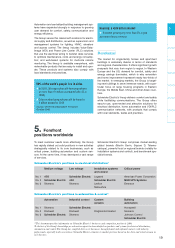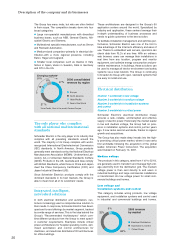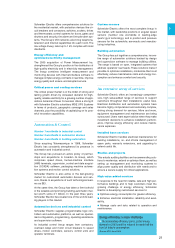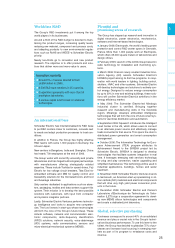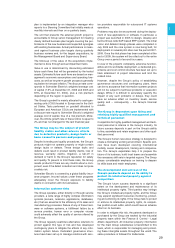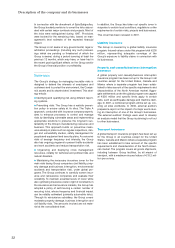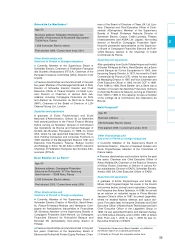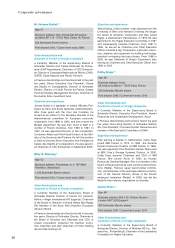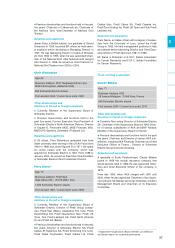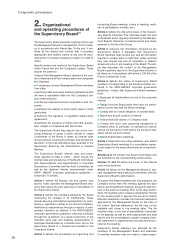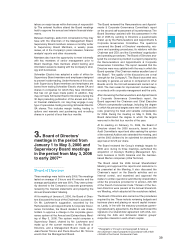APC 2006 Annual Report Download - page 31
Download and view the complete annual report
Please find page 31 of the 2006 APC annual report below. You can navigate through the pages in the report by either clicking on the pages listed below, or by using the keyword search tool below to find specific information within the annual report.
plan is implemented by an integration manager who
reports to a Steering Committee that initially meets at
monthly intervals and then on a quarterly basis.
The unit that presents the external growth project is
accountable to Group senior management for meeting
clearly defined business plan targets covering the per-
formance of the new business and expected synergies
with existing businesses. Actual performance is meas-
ured against business plan targets during quarterly
business reviews and, for the largest acquisitions, by
the Management Board and Supervisory Board.
The follow-up of the value of the acquisitions imple-
mented is done through annual impairment tests.
Value in use is determined by discounting estimated
future cash flows that will be generated by the tested
assets. Estimated future cash flows are based on man-
agement’s economic assumptions and operating fore-
casts, as well as long-term growth prospects generally
equivalent to forecast inflation. The discount rate corre-
sponds to Schneider Electric’s weighted average cost
of capital (7.5% at December 31, 2006 and 2005 and
8.5% at December 31, 2004), plus a risk premium
depending on the region in question.
The Group’s goodwill is mainly allocated to cash-gen-
erating units (CGU) located in Europe and in the Unit-
ed States. Tests performed on goodwill allocated to
European and American CGUs are implemented with
a discount rate equal to Schneider Electric’s weighted
average cost of capital, free of a risk premium. More-
over, the infinite growth rate of these CGUs is equal to
2% and has not changed for the last financial year.
The Group may be the subject of product
liability claims and other adverse effects
due to defective products, design faults or
harm caused to persons and property
Despite its testing and quality procedures, the Group’s
products might not operate properly or might contain
design faults or defects. These design faults and
defects could result in product liability claims, loss of
revenue, warranty claims, litigation, a fall-off in
demand or harm to the Group’s reputation for safety
and quality. To prevent or limit these risks, the Group
recalls products if there are any doubts about a com-
ponent, even if the defect is random and does not pose
a safety risk.
Schneider Electric is covered by a global liability insur-
ance program. Insured values under these programs
adequately cover the Group’s exposure to liability
claims in connection with its businesses.
Information systems risks
The Group operates, either directly or through service
providers, a wide range of highly complex information
systems (servers, networks, applications, databases,
etc.) that are essential to the efficiency of its sales and
manufacturing processes. Failure of any of these hard-
ware or software systems, a fulfillment failure by a
service provider, human error or computer viruses
could adversely affect the quality of service offered by
the Group.
The Group regularly examines alternative solutions to
protect against this type of risk and has developed
contingency plans to mitigate the effects of any infor-
mation system failure. Dedicated governance struc-
tures have been set up to manage relations with serv-
ice providers responsible for outsourced IT systems
operations.
Problems may also be encountered during the deploy-
ment of new applications or software. In particular, a
project was launched in 2005 to design, develop and
build a Group-wide SAP-based ERP system.The initial
vision and detailed design phases were completed in
July 2005 and the core system is now being built, for
deployment on several pilot sites over the period 2007-
2009. Once the trial phase has been completed at the
end of 2009, the system will be rolled out to the entire
Group over a period of around four years.
In view of the project’s complexity, extensive function-
alities and its worldwide deployment, a dedicated gov-
ernance and cost control structure has been set up to
track attainment of project milestones and limit the
related risks.
However, despite the Group’s policy of establishing
governance structures and contingency plans, there
can be no assurance that information systems projects
will not be subject to technical problems or execution
delays. While it is difficult to accurately quantify the
impact of any such problems or delays, they could
have an adverse effect on inventory levels, service
quality and – consequently – the Group’s financial
results.
The Group is dependent upon hiring and
retaining highly qualified management and
technical personnel
Competition for highly qualified management and tech-
nical personnel is intense in the Group’s industry. Its
future success depends in part on the Group’s ability
to hire, assimilate and retain engineers and other qual-
ified personnel.
The Group’s human resources strategy is designed to
create a motivating working environment. Specific poli-
cies have been developed covering international
mobility, career development, training and compensa-
tion. The Group’s expatriates help it to prepare the
future of its business, build local teams and assemble
the necessary skill-sets in targeted regions. The Group
places considerable emphasis on training to deepen
its skills base and retain employees.
The development and success of the
Group’s products depend on its ability to
protect its intellectual property against
competitors
The Group’s future success depends to a significant
extent on the development and maintenance of its
intellectual property rights. Third parties may infringe
the Group’s intellectual property rights, and the Group
may expend significant resources monitoring, protect-
ing and enforcing its rights. If the Group fails to protect
or enforce its intellectual property rights, its competi-
tive position could suffer, which could have an adverse
effect on its business.
In order to mitigate this risk, the patents developed or
purchased by the Group are tracked by the industrial
property team within the Finance & Control - Legal
Affairs department. All industrial property information
for the main Group subsidiaries is transmitted to this
team, which is responsible for managing and protect-
ing these intangible assets throughout the world. The
same procedure is followed for trademarks.
29
1


